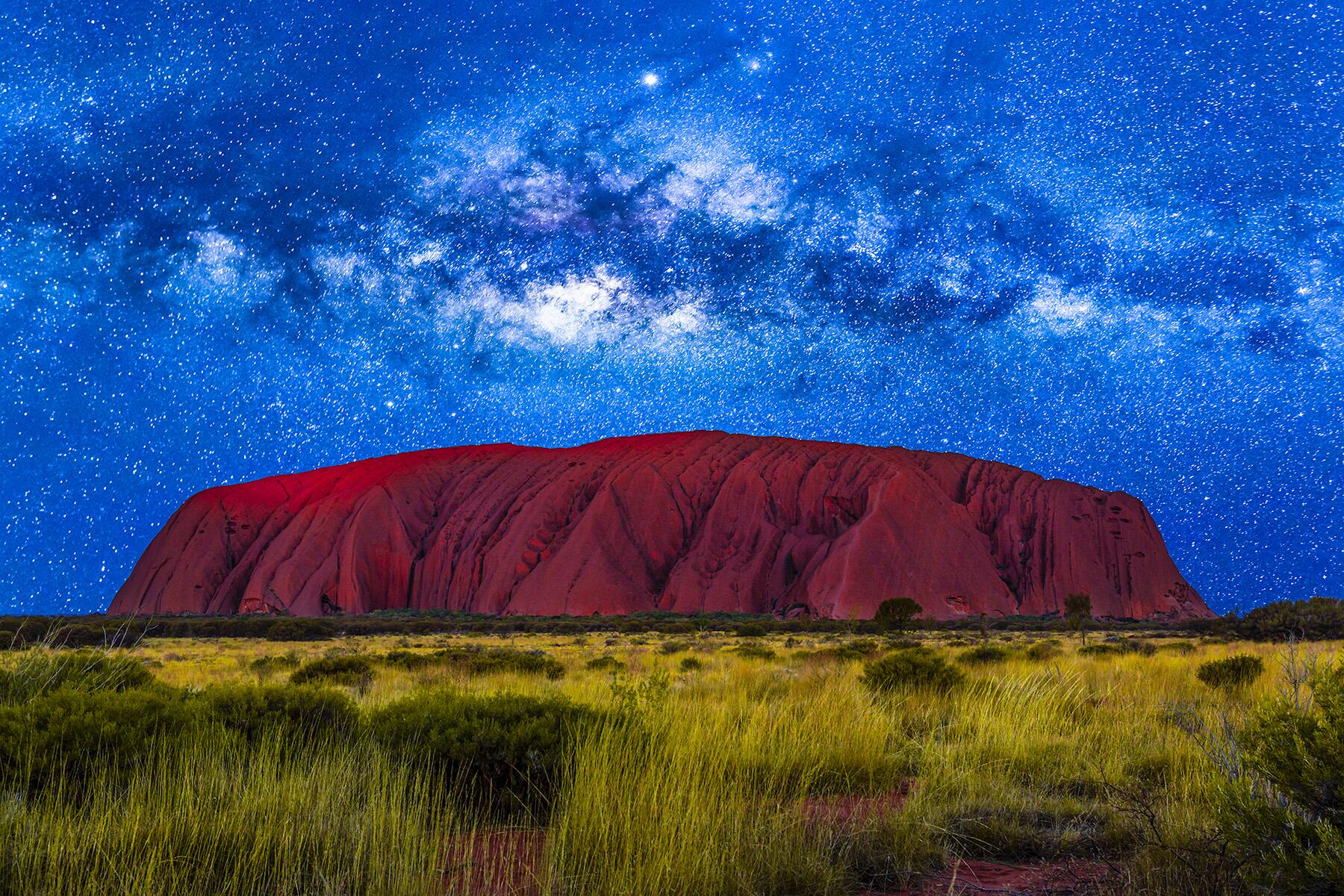“To ignore the night sky means you are only seeing half of the world.”
Australia lives up to its reputation of being the “Lucky Country,” particularly when it comes to stargazing. The Southern Hemisphere proves to be just as beautiful for night viewing as the reputable Scandinavian skies where you find the Aurora Borealis.
Many parts of the world, including Kiruna in Sweden, Kruger National Park in South Africa, and Natural Bridges National Monument in Utah, offer glittering night shows and are seen as a hotspot for Astro-tourism. But dark sky destinations for sky gazing are dwindling down to single figures. Recently, scientists have reported that more than 80 percent of the population now live under polluted skies. Despite many cities living under starless conditions due to heavy city smog pollution produced by factories and motorists, there is another form of pollution hampering the clarity of stars at night: light.
Light pollution is a type of pollution that is caused by excessive use of lights at night (e.g., street lamps, skylines, artificial indoor light). Even energy-saving products like LED lights, which are used to reduce energy bills, contribute to this unforgiving form of pollution. Currently, it is estimated that more than 30% of people in the world cannot see the Milky Way because of light pollution caused by humans. This has been linked to disruption in both plant and wildlife development. For example, in Australia, the mountain pygmy possum, a native marsupial, is endangered because its main food source, bogong moths, are unable to migrate to their winter breeding ground in Queensland due to artificial lighting interrupting their journey.
Recommended Fodor’s Video
For Indigenous peoples in Australia, light pollution has proven to be more than just detrimental to the natural environment. It affects their ability to carry on cultural traditions to future generations, which some researchers say amounts to cultural genocide. Aboriginal and Torres Strait Islanders have been observing the skies for millennia, well-before telescopes were invented, ultimately using this know-how for navigation, mapping seasons, and cultural practices.
Duane Hamacher, Associate Professor of Cultural Astronomy at the University of Melbourne, says that more than just fauna and flora are being impacted by the excessive use of lights.
“Light pollution negatively impacts human health, culture, animal health, psychology, and the wider environment. Everyone benefits from a clear view of the stars, and we all benefit from less light pollution,” says Hamacher.
The Original Astronomers
Hamacher is the author of The First Astronomers, a book about how Aboriginal and Torres Strait Islander Elders read the night sky and the importance of translating this tradition and culture to future generations. He tells me that Aboriginal peoples were the original astronomers and have always used the night sky as a form of navigation. Unlike Western astronomy, these Indigenous communities use astronomical information for cultural and social relevance. Without this connection, “culture, identity, spirituality, and traditional practices will be deeply impacted,” shares Hamacher.
“By disconnecting the people with their view of the stars, their library of knowledge is being erased, as is their spiritual and cultural connection to the stars. Whether the increase in light pollution is deliberate or not, the complete lack of any consideration or even acknowledgment of this well-known fact is a testament that no care is being taken. This is a form of slow violence. The gradual erasure of the stars through light pollution is impacting Indigenous communities who rely on a clear view of the stars.”
Aboriginal peoples have been described as the world’s first astronomers, with a history dating back more than 65,000 years. Reading the night sky is more than just cultural observations–these learnings and know-how help these Indigenous communities survive and live as their ancestors did. Unlike Western astronomy, Indigenous peoples do not use high-tech equipment but rather millennia-old knowledge to read the stars.
“When Elders describe reading the stars, what they mean is one’s ability to observe and interpret the changes in the positions and properties of celestial objects, no matter how subtle. [For example] the rising and setting of stars at dusk and dawn can be used as a seasonal clock,” says Hamacher. “Changing properties of the stars, such as their brightness or color, can tell you about changes in atmospheric conditions, which can be used to forecast weather and changes in the position of the sun mark out the year, and the moon’s phases mark out months.”
“Knowing how to read the stars means you can use them to navigate land and sea. You can also map out journeys across the land in the stars to teach new generations and commit the knowledge to memory. Knowing how to link changes in the stars to our atmosphere helps you predict seasonal change. The movements of stars and constellations can guide gardening, gathering, and hunting as the cosmos can be used to mark out animal and plant behaviors.”
Many Aboriginal Australians have a deep connection to the stars and planets, particularly their movement across the night sky, as described by the National Trust Organization of Australia. Knowledge of the night sky has always been used for navigation, creating calendars, and harvesting food sources for centuries by tribes in Australia–Indigenous peoples across Australia are hunters/gatherers who move across the country to take advantage of the seasonal food sources.

Written in the Stars
Ray Norris, a professor at CSIRO and Western Sydney University, has dedicated his work to understanding Indigenous culture and night sky activities in the Aboriginal and Torres Strait community. “The stars are used as a calendar, as a reminder of sacred stories, and for navigation and can be [observed] either through songlines [Aboriginal walking trails tied to creation and contemporary stories] or by memorizing the sky and using it as a map that reflects the earth,” says Norris. “In many of the Aboriginal cultures, astronomy is an important part, and [is] featured in songs, stories, and ceremonies, as well as being used for practical purposes. The sky is often seen as mirroring the events of Earth and represents 50 percent of the world. So to ignore the night sky means you are only seeing half of the world,” says Norris.
One of the most popular stories linked to the night sky and specifically to view the Milky Way is the “Dark Emu.” Only found in dark patches and streaks between the stars of the Milky Way, the “Dark Emu” signals different food sources and tasks, which vary across the country, depending on the location and season. The Ku-ring-gai people in Northern Sydney, for example, use the “Dark Emu” to predict when to gather eggs from emu nests and when to hunt for birds for food–which are all governed by looking up at the sky, says Norris.
Carol Redford, a night sky tourism guide in Australia, has been working to promote night sky tourism for almost two decades and is fascinated by Indigenous astronomy. “The knowledge system is incredibly deep and complex. The night sky is used scientifically to guide care for the environment and people. So it’s something that’s not just astoundingly beautiful, but there are many scientific lessons the dark night sky gives.
These experiences in Australia are less common but can be found upon request with tour guides like Nyoongar Elder Dr. Noel Nannup and Hazel Walgar, a Baiyungu woman, and Traditional owners of the Ningaloo Coast. They offer culturally significant tours via Baiyungu Dreaming on the land, water, and sky.
Call It a Night
All seven states in Australia proudly boast their efforts to use more LED lighting in big and small cities, yet warnings about the detrimental effects LED lights have on the night sky—and, just as importantly, the traditions of the Indigenous community—by scientists like Norris and Hamacher are being mostly ignored.
“In recent years, light pollution has increased, ironically, from low energy ‘green’ LED lights. The LED lights most commonly used emit light in the blue end of the spectrum, which easily scatters to wash out the stars and is bad for our eyes and the health of wildlife. They are very bright, and because they are so cheap, their use is expanding rapidly,” says Hamacher, “The most common rationalization for their use is ‘safety,’ but study after study shows no connection between increased lighting and increased safety.
“Culture, identity, spirituality, and traditional practices will be deeply impacted by a lack of connection to the sky. We can mitigate the effects of light pollution by understanding and acknowledging the importance of darkness, using fewer lights, and using lights of cooler colors. The idea that ‘light equals progress’ must stop,” says Hamacher.
Nai agrees, “Yes, mainly as urban spread and growth, light pollution is making visibility of the night sky harder to see. Even for mainstream constituencies, they don’t even know there’s a whole universe lit up above them. I think Indigenous peoples, where their traditional country and story places once were and have been taken over by the urban sprawl, have lost certain vantage points because of light pollution, risking cultural knowledge.”




